 Kindle
KindleBéhasque, Sauveterre de Béarn, Jaureguia… The prehistorical nuances and mountain echoes of these place names sound quite familiar to me: this is the French side of the Basque country, that I find out to be both similar and disimilar to the Spanish part. On one hand, the villages and the architecture are alike, as is the gastronomy and some habits: the atmosphere, more people walking the streets, or drinking wine and eating tapas. Also signs and notices’ font type is the same as in “our” side, evidencing common roots. On the other hand, though, the Homo Basqus seems more tamed here, less wild; and I haven’t yet heard any Euskera spoken. I get the feeling that these Basques don’t (as the Spanish do) mistake or mix up the concepts of folklore and nationality; that they’re quite happy being French. Or perhaps it’s just that French language is sacred for France, and they don’t tolerate any region toying with the idea of pushing it to the background. Bi-lingual road signs seem to be the major concession to Euskera. But of course I can be totally wrong.
My sleep at Navarrenx was unbeatable; thanks God I was finally given a night off insomnia. Ahead of us (Rosaura and me, I mean) lay the Pyrenees mountain range, that we’re going to pass via one of the less trodden and most winding by-roads; and as I observe the landscape around me before and after crossing the border, I realize yet another important difference between both sides of this region: the French one seems to be a lot less industrial, and the environment is better taken care of; which is not a surprise, of course, knowing how admirably France respects its countryside and how secondary it is for us. They rather rely on agriculrure and farming than on factories and mining; but if they have some industry around here, it’s well out of sight or better integrated with the environment.
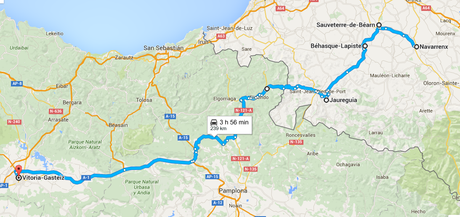
From Navarrenx to Vitoria over the Pyrenees
For staying overnight I choose Vitoria, where I was living one year before and I still keep a few acquaintances to spend a nice while with. Luckily, two of them are free, and we go out for a few tapas and as many wines, catching up with our news, sharing a laugh and a good chat. Then, back in my guesthouse, whose bar is shutting down, I have an argument with the employees because I’ve accidentally step on the just-mopped floor, and they’ve bad-mannerly scolded me; so we’ve had a row, and I’ve got untimely upset. This is the problem with Spain, a nation of rude and cocky people. Along one hundred and fifty days around Europe I haven’t had any trouble (except for those Polish assholes in Gorzów), but the moment I step on my country, I always come across some brazen one.
* * *
And it’s another day’s morrow. With this and that, I’ve had a bad night – though actually not worse than a few others this week. Maybe my subconscious is picking up the failure, the uselessness of this Journey to Nowhere which, indeed, I’m ending tomorrow without having actually got Anywyere. And perhaps this certitude – this feeling of a misused time – is pushing me onto the hands of anxiety. But there’s yet another factor: for as long as all broad Europe was ahead of front me, I not knowing where to head every day but living under the vague illusion – unfounded, yet real – that everything was still to come, it was relatively easy for me to shun the pessimism derived from my life’s wearisome uncertainty; but since, for the past two weeks, this journey’s conclusion is certain and nigh, then darker thoughts begin to haunt me, to chase me, like wolves sensing the weakness of a prey.
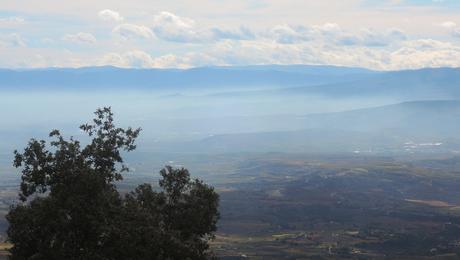
Rioja wine region, from Herrera pass
From Vitoria I head south towards Treviño county and the well-trodden roads that often saw me riding Rosaura hither and thither along a series of routes I took the year I lived there. Past the polemic county, we reach the Herrera mountain pass, natural border between Basque country and Castile, and from where one of the most majestic panoramics can be seen of the upper Ebro fertile valley known as Rioja, a renowned wine region.
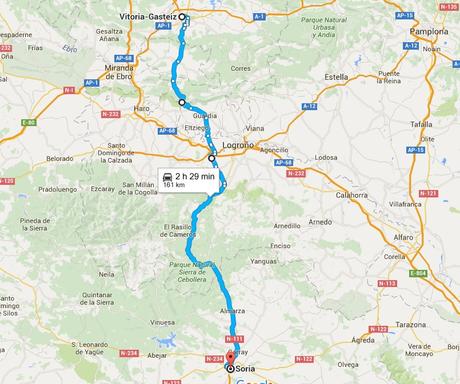
Route from Vitoria to Soria
Right after the province limits, and a bit before Logroño, I pull to the right and take route N-111 to Soria, one of Spain’s most spectacular roads; so much so that it would take a stop every quarter of a mile to shoot all the pictures those fascinating landscapes deserve; for which reason I rather opt for not stopping anywhere, lest I never reach my destination.
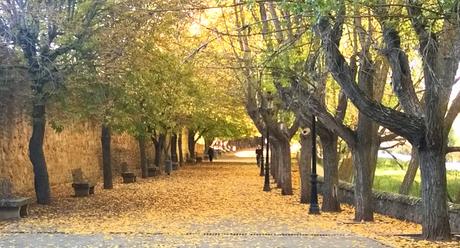
Poplar grove in Soria
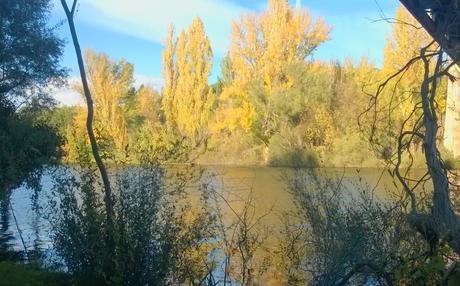
Duero riverbanks by Soria
One decade ago, Soria was my residence for one year, whereof I keep pleasing, soothing memories. Today I don’t hesitate to stay – out of fondness and nostalgy – in the old-times guesthouse I used to live in: Casa Diocesana (Diocesan Guesthouse). How fondly was I always received and treated there! The staff was a bit like my family and Casa was like my home. The calm is total in that centric yet tranquil building, where even nowadays you still get the blessing of a TV free room! This is a luxury nowadays: the only no-TV hotel during my whole journey. Well done! For the rest, I was afraid time and modernity had spoiled Casa Diocesana’s retreat atmosphere, but I gladly see it’s still the same endearing place it was back then… though good old Basilia is gone, they tell me she’s retired. I keep you near my heart, Basilia. You so fondly used to feed me when I, disregarding the dining room, rather came to the kitchen and sat there with you ladies. Pilar, though, is still around and so are the director and receptionists. And even that scatterbrain, that crackpot boozer of Luis still lingers on, granted full board out of sheer charity.
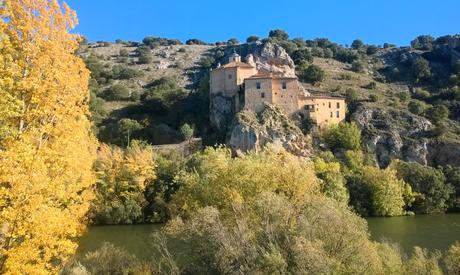
Saint Saturio sanctuary, in the outskirts of Soria
In the afternoon I take a long walk to Saint Saturio (beyond the Duero’s crossbow bend) with the goal of rescueing some memories from my pouch of recollections. Not memories of that far off trip we took with the class when at highschool, when the world was young and the snow covered the city, but of my last stay, so I can indulge myself in the bittersweet pleasure of remembering.
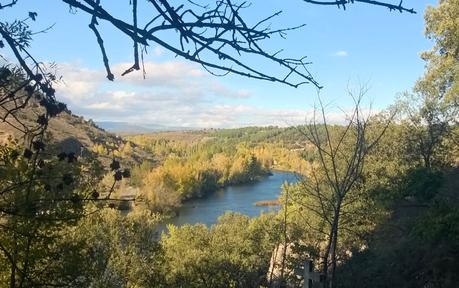
Duero’s crossbow bend around Soria
The leafy riverbanks are beaming now under this afternoon’s warm fall sunlight. On my return to town, when going past the cemetery, I step in and stop for a few minutes by the tombstone of Leonor Izquierdo, the poet Antonio Machado’s young and short-lived wife, deceased twice as many years ago as my age is today; and (despite not being a believer) I pray within myself a short prayer for both. How briefly they got to enjoy their life together!
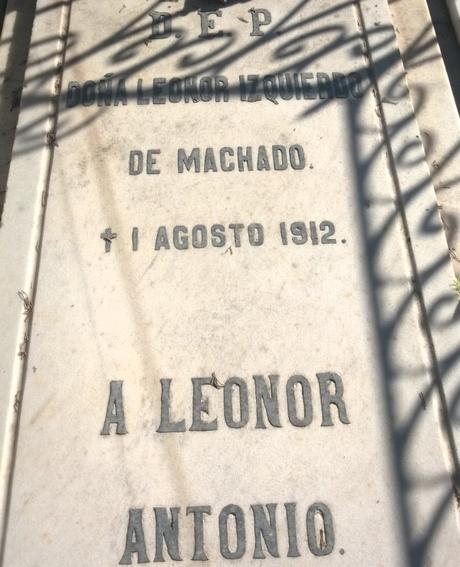
Grave of Leonor
In the evening I go out for some wine and tapas, a serving of croquettes, and then back to my room. I’d have liked to come across any of my old acquaintances, but I wasn’t lucky. The workmates I used to go out with are gone, and to the others I feel like a stranger.
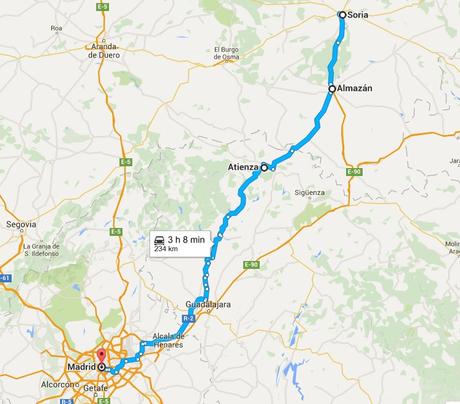
Last stage, and return to Nowhere
Today, October 17th, I pronounce finished this Journey to Nowhere. In about two hours I’ll arrive to Madrid, from where I set off, so this will be my last note. It’s a windy day, partly overcast. The clouds drag their swift shadows over Soria’s empty, barren land.
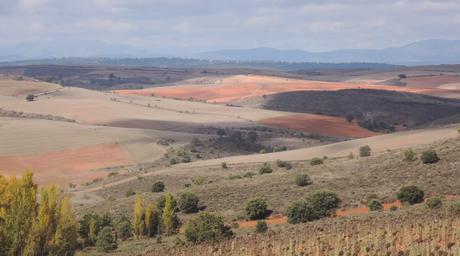
Arid lands of Soria
I am looking at poor Soria’s arid, sad fields between Almazán and Atienza, where only a few stunty and ashen sunflowers grew. Sterile, ferrous fields burnt by the sun, lashed by the wind, you are like this soul of mine..,
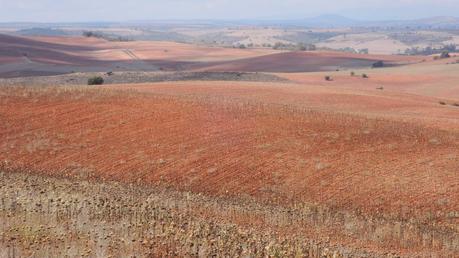
Poor sunflower fields
previous chapter

